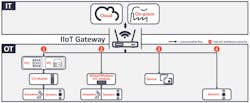IoT Analytics, a provider of market insights and business intelligence related to the IoT (Internet of Things), AI (artificial intelligence), cloud, edge and Industry 4.0, notes that the industrial IoT gateways market accelerated significantly from 2021 to 2022, growing nearly 15%. Since the term “gateway” can be used to reference a few different technologies, IoT Analytics points out that these findings refer to ruggedized hardware that connects sensors, IIoT devices and industrial equipment to cloud or on-premises servers or PLCs and industrial PCs (IPCs) operating on distinct industrial networks.
Key factors driving the growth of IIoT gateways include:
• Many companies are retrofitting their legacy equipment with sensors and controllers and using IIoT gateways to perform necessary protocol and data transformation and transfer the data to an IT endpoint.
• Companies with connected equipment are moving some applications to the cloud, with IIoT gateways emerging as the main nexus point for information flow in and out of industrial premises. In addition, some applications are now run locally on the gateway itself.
• New, enhanced gateways with embedded multi-core processors, AI chipsets and secure elements are enabling faster and more secure data processing and transmission (to an IT endpoint or cloud).
Connecting IT and OT
Because many manufacturers maintain legacy equipment with sensors or controllers that connect locally, such as to a human-machine interface or panel PC on the factory floor, this equipment may not offer connectivity options or use messaging protocols needed for connection to the cloud or IT servers. In addition, some companies with IoT-enabled equipment may want to move data off-premises or enhance local data computation for automated responses before transmitting the data.
In both cases, IIoT gateways can connect with standalone or integrated sensors—either wirelessly or wired through I/O module masters—to transmit data to IT or cloud servers. As described below, they fit within many architectures found in industrial IoT solutions.
The four general IoT architectures in which IIoT gateways are commonly found are:
• Sensors/devices to PLC/IPC to IIoT gateway to cloud. In industrial environments with existing automation hardware, the sensors/devices to PLC/IPC to IIoT gateway to cloud architecture is very common. Field sensors or actuators are connected to I/O module masters. These I/O module masters transmit data to the on-premises PLC or IPC. The PLC/IPC is then connected to the IIoT gateway, which serves as a bridge between the PLC/IPC and the cloud. This architecture can be very powerful but also potentially dangerous, notes IoT Analytics, as the IIoT gateway can be configured to remotely access the entire architecture that sits below the PLC/IPC. While this setup enables any data to flow between IT and OT and thus any imaginable use case, it also has the biggest potential attack surface.
• Sensor to I/O modules to IoT gateways to cloud. In this case, simple sensors connect to I/O module masters. The I/O module master then uses wired or wireless connectivity standards to transfer data to IIoT gateways, bypassing any PLC or IPC. This architecture proves to be highly effective in scenarios where multiple sensors are arranged into clusters—the I/O module master acts as the central node for each cluster of sensors, efficiently gathering and transmitting data to the cloud via an IIoT gateway.
• Device sensors to IoT gateway to cloud. Here, devices equipped with single or multiple onboard sensors are connected directly to the IIoT gateway. This architecture is often deployed where non-standalone IoT devices are used (i.e., devices that cannot connect to the internet by themselves).
• Sensors to IoT gateway to cloud. IIoT gateways enable connections between sensors and cloud servers directly. This architecture can be found when retrofitting specific sensors on an asset (e.g., for condition monitoring) with the desire to bypass all other existing networks to avoid creating a security risk.
IIoT gateway benefits
In IoT Analytics’ analysis of 65 case studies, it identified several key benefits of IIoT gateway implementations. Following are the three principal benefits cited by end user companies:
• Better IT/OT integration. A common goal of IT/OT integration is remote monitoring and response. As an example, Vitesco Technologies Italy used Zerynth’s 4ZeroBox, an on-premises IIoT system for real-time monitoring and predictive maintenance. This enabled Vitesco to predict pneumatic valve malfunctions 24 hours in advance, which reduced assembly downtime and increased productivity.
• Reduced labor costs. While Vitesco saw a 50% reduction in its manual labor requirement with its 4ZeroBox application, Colombian steel manufacturer Corpacero cut costs associated with repair labor after partnering with IIoT services provider Senzary to deploy RotaryIQ and InsightsIQ solutions for predictive maintenance and remote machine management.
• Energy savings. Enterprise energy management analytics software provider Wattics partnered with Kontron to use Kontron’s KBox A-101 as a central edge node for Wattics Sentinel software at a customer’s site. It connects to the local energy grid and the Sentinel grid, facilitating meter configuration, reliable data collection, pre-processing, compression and secure communication.

